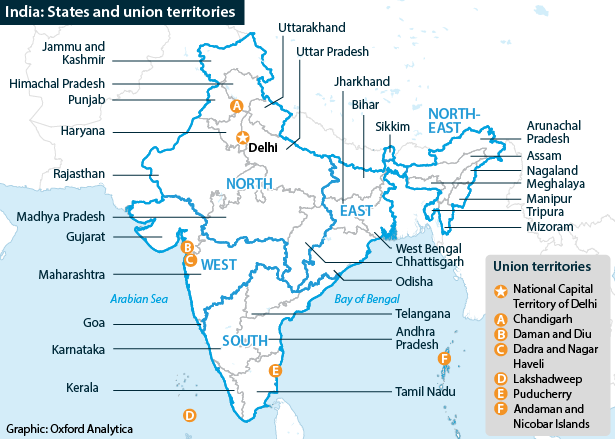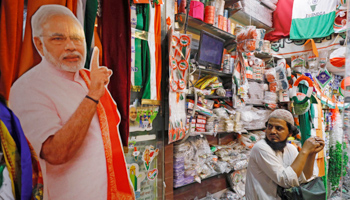Regional battles will be key in India’s election
Tomorrow sees the start of seven phases of polling in the general election
Voting in the general election begins tomorrow, ending on May 19 before the results are announced on May 23. Different states and union territories will go to the polls on different dates, with many voting in more than one phase. Prime Minister Narendra Modi’s Bharatiya Janata Party (BJP) faces a tough challenge from the main opposition Congress party and several regionally influential parties.
What next
The national parties will effectively fight different campaigns in different parts of the country, calibrating their approaches according to state and main opponent. The BJP may appeal to religious or caste sentiment in much of the north and west, but this would be less effective in most of the south and east. In the north-east, immigration will be the dominant issue. Modi will aim to engineer a personality contest with other leaders, believing that this will give his party the edge.
Subsidiary Impacts
- Anti-Pakistan nationalism would favour the BJP but, unless there are further cross-border hostilities, it is unlikely to be a key factor.
- Outbreaks of religious or caste violence are most likely in Uttar Pradesh and Bihar states.
- The post-poll government will struggle to rein in the fiscal deficit, with both main parties’ campaign pledges straining budgetary prudence.
Analysis
The election's seven phases take place on:
- April 11, 18, 23 and 29; and
- May 6, 12 and 19.
Uttar Pradesh (UP), Bihar and West Bengal states will see polling in all seven phases. Odisha, Andhra Pradesh, Sikkim and Arunachal Pradesh will also hold state elections during this period.
Some 900 million people will be eligible to vote in the general election.
900mn
Size of the Indian electorateIn the outgoing parliament, the BJP-led National Democratic Alliance (NDA) had some 342 out of 545 seats, with the BJP holding 269 of these.
The Congress-led United Progressive Alliance (UPA) had some 66 seats, with Congress holding 45 of these.
Platforms
The main parties will fight on a mixture of national and regional issues.
In the 2014 general election, national issues held sway. The NDA came to power as many voters reacted to the corruption associated with the outgoing UPA government, supporting Modi for either his appeal to economic development or his defence of Hindu nationalism (see INDIA: Modi could rely more on Hindu nationalism - September 19, 2018).
The question of national security recently came to the fore following a militant attack in Kashmir and subsequent escalation of India-Pakistan tensions (see INDIA/PAKISTAN: Tolerance levels will be pushed - March 1, 2019).
However, the nationalist sentiment generated by the cross-border confrontation is now dissipating.
Moreover, regionally based opposition parties have eschewed a nationwide anti-Modi alliance to contest the upcoming polls, underscoring the importance of regional concerns (see INDIA: Election will see patchwork opposition to Modi - March 21, 2019).
Regional picture
Modi and his opponents need to negotiate five different political terrains.
North and west
Across much of the north and west, the BJP's traditional heartlands, Modi's party is essentially involved in a straight fight with Congress.
In state elections late last year, Congress wrested Rajasthan, Madhya Pradesh and Chhattisgarh from the BJP. Modi's party lost rural and upper-caste votes there amid rising farmer hardship and contention over a lack of affirmative action for groups that now perceive themselves as socially disadvantaged.
Modi is offering renewed support for farmers and reserved quotas for upper-caste people in public institutions.
Congress is promising income support for poor families and an expanded jobs schemes for rural households.
In Modi's home state of Gujarat, Congress will aim to build on its performance in the 2017 state election, when it managed to reduce the BJP's majority.
In Maharashtra state, the BJP in partnership with the ethnocentric Shiv Sena will likely win more seats than Congress in alliance with the Nationalist Congress Party.
North and east
Modi's party is playing to its Hindu nationalist base by supporting causes such as a movement to build a temple in Ayodhya, UP, on the site of a mosque demolished by right-wing groups in 1992.
However, the BJP's appeal to Hindu nationalism is a risky strategy in UP and Bihar, where caste is as important a factor as religion (see INDIA: Modi’s party may renew emphasise on caste - December 21, 2018).
In 2014, Modi's party won 71 out of 80 parliamentary seats in UP by reaching out to communities of Dalits (formerly regarded as 'untouchables') and Other Backward Classes who felt marginalised by their nominal local champions, the Bahujan Samaj Party (BSP) and Samajwadi Party (SP) respectively.
This time, the BSP and SP have agreed a seat-sharing deal.
The pact excludes Congress, whose campaign in eastern UP is being led by party President Rahul Gandhi's sister Priyanka Gandhi Vadra. The anti-BJP vote could therefore be split, though Congress will likely struggle to win many seats.
In Bihar, Modi's advocacy of upper-caste quotas will not play well with lower-caste voters. Yet the BJP in partnership with the Janata Dal (United) will likely win more seats than Congress in alliance with the Rashtriya Janata Dal.
Bay of Bengal
Along the eastern coast, the BJP will aim to gain ground in states dominated by regional parties.
In West Bengal, Modi's party is unlikely to make much headway against West Bengal Chief Minister Mamata Banerjee's All India Trinamool Congress. The BJP's Hindu nationalism has less traction in a state where nearly 30% of the population is Muslim.
Nevertheless, the BJP could still win more votes than Congress or the communist Left Front.
In Odisha, Modi's party has a chance of eclipsing Naveen Patnaik's Biju Janata Dal.
South
Neither the BJP nor Congress will likely win many parliamentary seats in Andhra Pradesh, where the main contest will be between the Telugu Desam Party and the YSR Congress Party.
Karnataka will likely see a tough fight between the BJP and an alliance of Congress and the locally influential Janata Dal (Secular), which prevented Modi's party from taking power in last year's state election.
Tamil Nadu may also see a close contest. The BJP has secured an alliance with the All India Anna Dravida Munnetra Kazhagam, the third-largest party in the outgoing parliament, but Congress is backed by the Dravida Munnetra Kazhagam, and appears to be gaining ground.
North-east
In the north-east, the BJP is attempting to recover support following a backlash prompted by its Citizenship (Amendment) Bill.
Modi's party had sought to bolster its Hindu nationalist credentials by offering Indian citizenship to non-Muslim illegal migrants from neighbouring South Asian countries, but many in the north-east feared increased migration to the region. The bill passed the parliamentary lower house in January, but the BJP allowed it to lapse in the upper house in February.
The BJP's North-East Democratic Alliance remains intact but, with the party saying it will reintroduce the bill if re-elected, it may lose parliamentary seats in the region (see INDIA: Ruling party will lose support in north-east - March 8, 2019).
Political arithmetic
Indian opinion polls are notoriously unreliable, especially for general elections.
Yet in the light of surveys published recently, the NDA appears likely to win 260-90 seats; possibly a majority, but a reduced one if so.
The UPA and 'others' could win a roughly equal share of seats.
Notably, the opinion polls suggest UP's seats will be equally split between the BJP and the BSP-SP combine.
UP could be an election bellwether of sorts
If the result nationally reflects similar sentiment for and against Modi, leaving a hung parliament, unaffiliated parties could be kingmakers. Congress would likely reach out to them in the hope of forming, belatedly, a broad anti-Modi front to wrest power.

